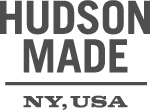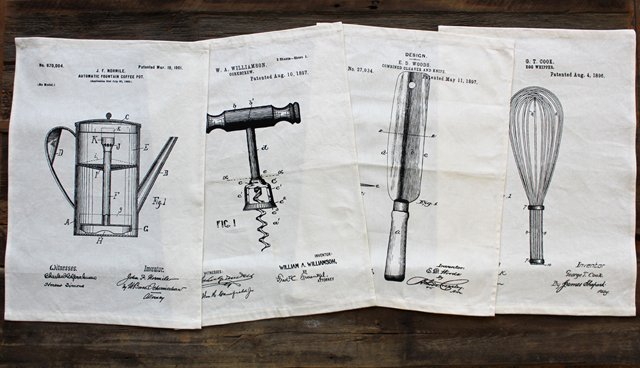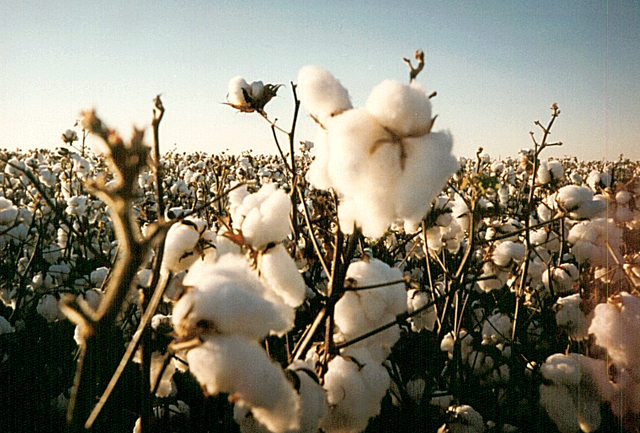Once upon a time, back when horses and wagons roamed the Earth and the telephone was a twinkle in Alexander Graham Bell’s eye, tea towels were found in every Victorian English lady’s kitchen.
Typically made from absorbent, finely woven soft linen, tea towels were ideal for drying china, glassware and delicate serving pieces without fear of scratching or leaving a lint residue.
During the Great Depression in the United States, hard-earned cash was needed for necessities like food and shelter. Americans diligently sought to make use of everything. For the housewife, this meant re-using and re-purposing whatever she could find for her family.
Enter the feed or flour sack. The cloth bags that contained animal feed, flours or grains were made from coarse cotton, and while they didn’t look too dainty at first, they were readily available and absorbent. Cut into a suitable size and hemmed, resourceful women would borrow the English style of embroidering the pieces to make them look more feminine and decorative. Industry eventually caught on and sellers would commission artists and designers to spruce up the sacks, thereby increasing sales to keen-eyed women who were just as interested in the sack as what was inside it.
Today, the tea towel has evolved into what most of us call dishtowels and can be found adorning refrigerator and oven door handles in kitchens across America.
By using and re-using a cloth towel, you’re also doing your part to protect the environment.
EllynAnne Geisel, author of The Kitchen Linens Book: Using, Sharing, and Cherishing the Fabrics of Our Daily Lives, credits her mother-in-law with first igniting her interest in kitchen linens.
“More to the point,” she stresses, “it was her daily use of her linens that influenced how I enjoy my own collection.”
“And with my environmental awareness heightened, I’m practicing a less wasteful lifestyle by replacing paper goods with those of vintage cloth.”
According to Care2, a social action network devoted to people who want to lead a sustainable and socially responsible lifestyle, paper accounts for one-third of municipal landfill waste. Replacing paper with cloth wherever we can is, in fact, more eco-friendly. Electric dryers are actually twice as energy-efficient as the manufacture of paper towels, according to the Care2 website. When you take into account the millions of trees used to make napkins and the chemicals used to bleach the pulp, why not use cloth? Even though a cloth dishtowel may go through a similar process, it gets used over and over rather than making a quick trip to the landfill.
Better yet, choose towels that are made with a combination of hemp or linen, both of which are more sustainable then pure cotton. And yes, organic cotton is vastly different from conventional cotton because it won’t contain the same pesticide residue.
The really fun part of them nowadays, though, is that their form and function extend beyond the kitchen. Hudson Made’s tea towel collection pays homage to patented designs of the 19th and early 20th centuries, showcasing timeless ingenuity that will spark conversation wherever they appear in one’s home.For Wrapping: A gorgeous tea towel as giftwrap? Imagine a gift basket of gourmet coffees, biscotti and a French press wrapped tidily in a beautiful towel featuring a 1901 patent sketch of an automatic fountain percolator coffee pot.
For Guests: Printed with creative designs, tea towels can easily find their place in a guest bathroom as an inventive way to showcase your personality or that of your guest. A towel printed with a vintage corkscrew, for example, is a thoughtful way to honor a guest who happens to be a wine enthusiast.
For the Kitchen: Sure, kitchen-themed towels make perfect sense to dry a pot, but consider cleverly designed towels such as a cleaver and knife or a whisk as cloth napkins for your next dinner party.
As a chef, I like anything that has more than one use in the kitchen. Dishtowels are the original multi-purpose wipe, with more beautiful designs available than ever before to turn this kitchen workhorse into a bonafide linen you’ll be proud to use.
 |
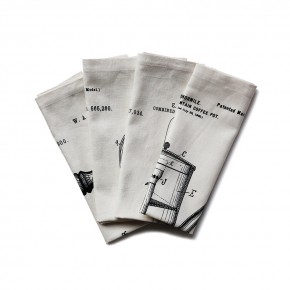 |
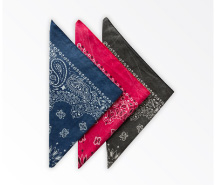 |
| Scullery Soap | The Tea Towel Set | Hudson Made Bandana |
Laura Grimmer is a professional cook and sommelier who lives to eat, drink and provide sustenance. She came late to the culinary world, selling her PR firm and enrolling at the French Culinary Institute because of a borderline fixation on master chef Jacques Pépin. She left cooking school a classically trained chef with a deeply seated appreciation for tradition in the kitchen. http://www.perfectpairnyc.com
